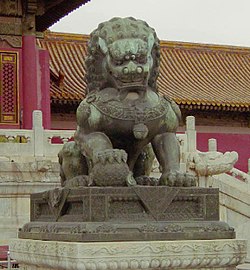
Back أسود حارسة صينية Arabic Кучета Фу Bulgarian Lleons de Fu Catalan Čínský lev Czech Wächterlöwe German Leones de Fu Spanish شیرهای نگهبان چینی Persian Leijonakoira Finnish Lion gardien chinois French Leóns de Buda Galician
This article needs additional citations for verification. (September 2021) |
| Chinese guardian lions | |||||||||
|---|---|---|---|---|---|---|---|---|---|
 A Ming-era guardian lion in the Forbidden City | |||||||||
 A Qing-era guardian lion pair in the Forbidden City. Note the different appearance of the face and details in the decorative items, compared to the earlier Ming version. | |||||||||
| Chinese name | |||||||||
| Traditional Chinese | 獅(子) | ||||||||
| Simplified Chinese | 狮(子) | ||||||||
| Literal meaning | lion | ||||||||
| |||||||||
| Alternative Chinese name | |||||||||
| Traditional Chinese | 石獅(子) | ||||||||
| Simplified Chinese | 石狮(子) | ||||||||
| Literal meaning | stone lion | ||||||||
| |||||||||
| Khmer name | |||||||||
| Khmer | សឹង្ហ singha | ||||||||
| Thai name | |||||||||
| Thai | สิงห์ sǐng | ||||||||
| Sinhala name | |||||||||
| Sinhala | සිංහ siṁha | ||||||||
| Sanskrit name | |||||||||
| Sanskrit | सिंहः
sinha | ||||||||
| Burmese name | |||||||||
| Burmese | ခြင်္သေ့ chinthe | ||||||||
| Tibetan name | |||||||||
| Tibetan | གངས་སེང་གེ gangs-seng-ge | ||||||||
Chinese guardian lions, or imperial guardian lions, are a traditional Chinese architectural ornament. Typically made of stone, they are also known as stone lions or shishi (石獅; shíshī). They are known in colloquial English as lion dogs or foo dogs / fu dogs. The concept, which originated and became popular in Chinese Buddhism, features a pair of highly stylized Asiatic lions—often one male with a ball which represents the material elements and one female with a cub which represents the element of spirit— that were thought to protect the building from harmful spiritual influences and harmful people that might be a threat. Used in imperial Chinese palaces and tombs, the lions subsequently spread to other parts of Asia including Japan (see komainu), Korea, the Philippines, Tibet, Thailand, Myanmar, Vietnam, Sri Lanka, India, Nepal, Cambodia, Laos, and Malaysia.
© MMXXIII Rich X Search. We shall prevail. All rights reserved. Rich X Search